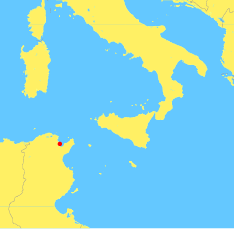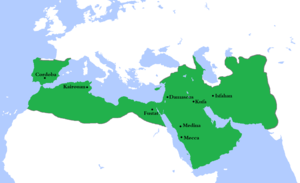Battle of Carthage (698)
The Battle of Carthage was fought in 698[1] between a Byzantine expeditionary force and the armies of the Umayyad Caliphate.
| Battle of Carthage | |||||||||
|---|---|---|---|---|---|---|---|---|---|
| Part of the Muslim conquest of North Africa and the Arab–Byzantine Wars | |||||||||
Roman Carthage was destroyed, its walls torn down, its water supply cut off, and its harbors made unusable. | |||||||||
| |||||||||
| Belligerents | |||||||||
| Umayyad Caliphate | Byzantine Empire | ||||||||
| Commanders and leaders | |||||||||
| Hasan ibn al-Nu'man |
John the Patrician, Tiberius Apsimarus | ||||||||
| Strength | |||||||||
| 40,000 | Unknown | ||||||||
| Casualties and losses | |||||||||
| Low | High | ||||||||

Prelude
Having lost Carthage to the Muslims in 695,[2] Emperor Leontios[3] sent the navy under the command of John the Patrician[4] and the droungarios Tiberius Apsimarus. They entered the harbor and successfully recaptured it in a stunning surprise attack in 697,[3] which resulted in the city's Arab forces fleeing to Kairouan.
Preparation
Emir Hasan ibn al-Nu'man was in the middle of a campaign in the Greater Maghreb region, but withdrew from campaigning in the field to confront the renewed Roman challenge to the emerging caliphate and he drew plans at Kairouan to retake Carthage the following spring. It is estimated that he headed a force of 40,000 men.[5] The Romans sent out a call for help to their allies, the native Berbers, and to enemies the Visigoths and the Franks.[4] Despite the king of the Visigoths, Wittiza, sending a force of 500 warriors in order to help defend Carthage, the Romans were in disarray due to in-fighting and were sapped of much of their strength.
Battle
Hasan ibn al-Nu'man, enraged at having to retake a city that had not resisted the Roman take over, offered no terms except to surrender or die. The Emperor Leontios had also given his forces instructions of victory or death. The Romans left Carthage and attacked the Emir's army directly, but were defeated, and the Roman commander decided to wait out the siege behind the walls of Carthage to let the Arabs exhaust themselves, since he could continue to be resupplied from the sea. The defenders were faced with Hasan's overwhelming force deployed in ferocious attacks as his men made repeated attempts to scale the walls with ladders. They combined this land assault with an attack from the sea that caused the Roman commanders to withdraw from the city and subsequently resulted in the second and final great destruction of Carthage. The Romans retreated to the islands of Corsica, Sicily, and Crete to further resist Muslim expansion.
Aftermath

John the Patrician was later murdered after a conspiracy at the hands of his co-commander, Tiberius Apsimarus. Tiberius Apsimarus then, instead of taking the step of returning to Africa to fight the Muslims, sailed instead to Constantinople. After a successful rebellion, he rose to the throne as Tiberius III,[4] and was later deposed by former emperor Justinian II, now known as the Rhinotmetus.
The conquest of North Africa by the forces of Islam was now nearly complete. Hasan's forces met with trouble from the Zenata tribe of Berbers under al-Kahina,[6] and they inflicted a serious defeat on him and drove him back to Barqa. However, in 702 Caliph Abd al-Malik strongly reinforced him. Now with a large army and the support of the settled population of North Africa, Hasan pushed forward. He decisively defeated al-Kahina in the Battle of Tabarka, 85 miles (136 km) west of Carthage. He then developed the village of Tunis, ten miles from the destroyed Carthage.
References
- "Tunisia - Carthage". www.sights-and-culture.com. Retrieved 20 September 2012.
- "ʿAbd al-Malik". www.britannica.com. Retrieved 20 September 2012.
- "Leontius". i-cias.com. Retrieved 20 September 2012.
- Moore, R. Scott. "Leontius (695-98 AD)". www.roman-emperors.org. Retrieved 20 September 2012.
- "Battle of Carthage (698)". www.myetymology.com. Retrieved 20 September 2012.
- "The Kahina". awalimofstormhold.wordpress.com. Retrieved 20 September 2012.